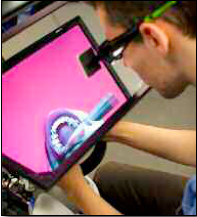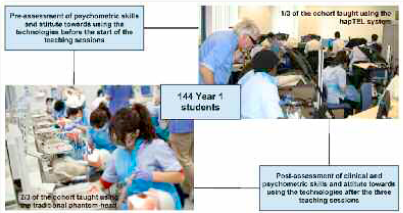By Margaret J. Cox, Jonathan P. San Diego & Barry Quinn
Previous studies have shown that a range of manipulative clinical skills can be practiced through the use of haptics (sense of touch), such as tooth drilling, needle insertion, bone surgery, and instrumentation for gum diseases. Presently there is little evidence of what actual impact haptic devices might have on students’ learning, on the curriculum and on institutions’ adoption and integration of such technologies.
The hapTEL project, based at King’s College London Dental Institute, was set up in July 2007, and is funded by the UK’s Economic and Social Research Council and the Engineering and Physical Sciences Research Council, to develop, evaluate and integrate the use of haptics in dental education and investigate its impact on teaching and learning. The hapTEL team, which has won many awards for dental education and technological innovation, includes dentists, e-learning professionals and educational researchers at King’s College London, cyberneticists from Reading University and engineers from Birmingham City University.
The Development of the System
The technical development involved creating a realistic virtual mouth using MRI/CT scans of the human jaw combined with clinical expert feedback. The touch input device is based on that used in the gaming industry. A real dental drill connected to the device enables students to operate on the virtual mouth, feeling the difference between drilling hard healthy and softer decayed tooth tissues. Operated by a foot pedal, as in a regular dental chair, the students learn how much pressure needs to be applied in preparing a cavity. In order to see the virtual mouth in 3-D, shutter glasses are worn and students’ head movements are tracked by a camera to give them a real world experience of examining the mouth from different angles. The screen display shows the learning activities from selecting the patient case, to choosing the correct instruments and assessing clinical performance.
Fourteen identical workstations were produced and located in the clinical skills lab (CSL) at King’s College London. Figure 1 shows the hapTEL workstation being used by a student.
Identifying the Curriculum Use and Measuring the Curriculum Impact
In order to know if the system could be integrated successfully in the curriculum, the team firstly reviewed the traditional course to identify where haptics might most appropriately be used. Students worked in pairs, one as the “dentist” and the other as the “nurse.” The hapTEL system recorded computer logs of the interactions and the procedures performed. During traditional simulation students first learn to prepare small carious cavities advancing to more complex preparations.
Measuring the Impact on Students’ Learning
Previous studies on haptics have only reported limited measurements of the impact on students’ learning. The project therefore conducted two years of largescale student trials with one-third of the 144 Year 1 students using the hapTEL devices and the other two-thirds learning in the traditional laboratory. Figure 2 shows the trials’ arrangements.
Feedback from the first year trials enabled the system to be improved for the second year. For each year cohort a series of pre- and post-tests were developed and used to measure the students’ psychomotor skills, what they had learned, and their attitudes towards using the system and whether there were any differences between the groups’ learning outcomes.
Project Outcomes
The project has obtained many useful outcomes from this large study.
The first difficulty students encounter is learning to hold the instruments correctly and ergonomically positioning the patient. Further, they often use too much pressure for too long with the concomitant removal of too much dental tissue. The hapTEL system allowed them to go through this process repeatedly without destroying plastic or natural extracted teeth which are in short supply. The students were able to learn clinical skills to expeditiously prepare carious virtual teeth and transfer these skills into the real clinical environment. The student and tutor could also play back a video to examine the technique and to see how much decayed versus healthy tooth they had removed.
Comments included, “The device has taught the students to become more selfcritical and that skill is just as important as the manipulation.”
“When you first come into dentistry everything is very alien to you, the way you position your hand, the tiny movements that you need to perform procedures. These are difficult to achieve. The hapTEL system allows you to repeat a task over and over again, it gets ingrained into your muscle memory, and improves your manual dexterity.”
The results of the large-scale tests showed no statistical difference between the groups; hapTEL trained students performed equally as well as traditionally trained.
Cost Savings using the hapTEL System
Traditional training is performed on a mannequin with plastic teeth. The research showed that an advantage of the hapTEL system is the instant analysis, review and repetition. One hapTEL device costs approximately £10,000, compared with the £30,000- £40,000 price for a traditional simulator with the added cost of using multiple plastic teeth. Multilayered anatomical plastic teeth cost approximately £16 each.
Future Developments
This study has shown that the hapTEL system can provide equally effective training as the traditional system with the additional advantages of costing less and providing documented individualized feedback to every student. The same hapTEL system could be used for dental hygienists, medical and nurse education on a wide variety of procedures from suturing to injections. Further technological developments would provide the opportunity to broaden its application to other fields and contexts. For example, patient rehabilitation after stroke is possible, improving motor skills with feedback and monitoring of progress.
At the moment, the hapTEL system is still being developed, but additional functionality will make it a marketable product that could be made available to other healthcare institutes for tutor-led or independent study.
Acknowledgements: hapTEL™ is part of the Technology-Enhanced Learning Programme (TEL) funded by the United Kingdom, Economic and Social Research Council (ESRC) and the Engineering and Physical Sciences Research Council (EPSRC) Award Number: RES-139-25-0387 (http://www.haptel. kcl.ac.uk).
Margaret J. Cox OBE, FKC Jonathan P. San Diego Barry Quinn The Dental Institute King’s College London United Kingdom mj.cox@kcl.ac.uk
About Brenda Wiederhold
President of Virtual Reality Medical Institute (VRMI) in Brussels, Belgium.
Executive VP Virtual Reality Medical Center (VRMC), based in San Diego and Los Angeles, California.
CEO of Interactive Media Institute a 501c3 non-profit
Clinical Instructor in Department of Psychiatry at UCSD
Founder of CyberPsychology, CyberTherapy, & Social Networking Conference
Visiting Professor at Catholic University Milan.








